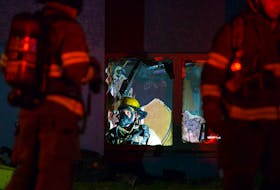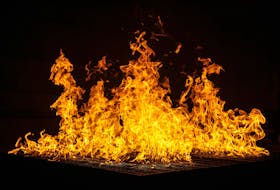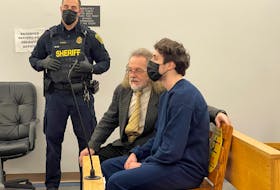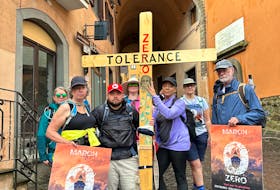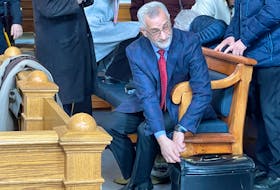Walt LeMessurier is full of stories and, once he gets going, he can be hard to stop.
That’s not surprising since he has led an active and quite colourful life for 90 years now.
The longtime Corner Brook resident, who was born in St. John’s in 1924 and came to the west coast in 1937, will be marking the special occasion with an open house at the Glynmill Inn from 2-5 p.m. Sunday.
The Western Star spent some time recently with LeMessurier in the comfort of his living room on Brookfield Avenue, where he reminisced about his days with the Royal Air Force in the Second World War and his rather impressive career as a multi-sport athlete.
It is perhaps as an athlete that LeMessurier is best known. In a career paralleled by few others, he excelled at soccer, baseball, hockey, softball, table tennis, billiards and golf. Making contributions to various sports as a builder, he was inducted into the Newfoundland and Labrador Sports Hall of Fame in November 1988.
Before going overseas, LeMessurier went to train for the Royal Air Force at Guelph University in Ontario with about 5,000 other men from all over the Commonwealth. One of his proudest moments is making the force’s soccer squad, which he said featured about half a dozen professional and semi-professional players from the United Kingdom, Australia and New Zealand.
Elected into the Newfoundland and Labrador Soccer Hall of Fame in 1983, LeMessurier went from being the top goalkeeper in 1951 and 1952 to being the top goal scorer in 1953. He captained Corner Brook’s all-star team to provincial titles in 1952 and in 1956.
He once batted .519 in the Corner Brook senior baseball league and often led the Corner Brook squad at the plate in provincial playdowns. An exceptional hockey player and softball pitcher/shortstop, LeMessurier was a western Newfoundland billiards champion, holds provincial titles in singles and doubles table tennis and represented Newfoundland and Labrador on the national stage in golf.
An avid runner and cross-country skier, LeMessurier last hiked the Blow-Me-Down Mountains at age 87.
Not too shabby for a wireless airgunner who flew many missions with the Royal Air Force in southeast Asia during the Second World War and came out of it unscathed. Some of those flights over the jungles or the Himalayan Mountains aboard their C-47, twin-engine plane were an honour to be a part of.
Some were downright harrowing.
LeMessurier was the only person from Newfoundland and Labrador who was present at the Japanese surrender. He and his crew were asked to fly dignitaries from various countries to the signing of the surrender in Rangoon, Burma in August 1945.
LeMessurier couldn’t recall the names of any important political figures who would have flown with him, but he’ll never forget the sight of the Japanese formally giving up the fight.
“The poor Japanese were just so defeated,” he recalled of the sight of the Japanese laying down their swords and their general being taken captive by the Allies.
The crew didn’t just sit around in between bringing the international bigwigs to and from Rangoon. They were also tasked with flying Allied prisoners of war back to hospitals in India.
“Holy Jesus, were they ever in so bad shape,” he said of his comrades who had been rescued from Japanese concentration camps. “The things they said were done to them was awful.”
Each of those flights usually had the capacity of 22 prisoners onboard. All of LeMessurier’s flights landed safely, but the same couldn’t be said of the planes flown by others.
One crew, which included a pilot from St. John’s and another member from Harbour Grace, decided to fly through one of the cumulonimbus clouds that peppered the southeast Asian sky during monsoon season. LeMessurier and the other planes in the squadron flew around the potentially dangerous storm cloud.
“One of the b’ys saw his aircraft going down with no wings on it,” LeMessurier said quietly. “No one’s heard from them since.”
He would not name the two Newfoundlanders, whom he knew quite well.
That’s not to say LeMessurier didn’t have his own close calls.
On one trip out of Rangoon, his plane’s starboard motor cut out 12,000 feet in the air and the plane began plummeting back to earth. LeMessurier was about to go tell the 22 prisoners of war aboard to prepare for a crash landing when his pilot miraculously managed to overcome the airlock that had caused the engine to stall. They were able to regain altitude and resume the flight.
He said it was an intense atmosphere trying to right the craft while staring at crashing into the remote jungle below.
“Just trying to talk to each other, knowing you were going to your death, it was bad,” he said.
Another tense moment happened with a British dignitary onboard. LeMessurier was chatting with the official when the plane suddenly began to rumble and shake.
It wasn’t the turbulence that he had gotten so used to. A bolt had come loose on one of the plane’s engines shortly after takeoff.
They turned around and landed, fixed the problem and took off again.
After the war, LeMessurier’s battles were mostly on the field of play as he made a relatively easy transition to life back in quiet Corner Brook. The only physical scar from the war is the 53 per cent reduction in his hearing caused by the constant and sudden ups and downs of flying through the turbulent monsoon skies of southeast Asia.
After a two-month vacation, he took a job as leasing manager with City Motors, a job he worked at until he retired 26 years later.
An active member of the community, he agreed to serve a four-year term as commanding officer for the local air cadet movement. He would go on to be the commanding officer for more than 18 years.
He’s seen a lot of changes in Corner Brook in all that time, mostly for the good, he said. He also saw many of those young air cadets go on to be civic-minded contributors to their community.
When he thinks of the poverty, squalor and inhumanity he has seen in his life experiences, LeMessurier said people should appreciate the good fortune they have in the western world.
“When you’ve been all over the world, I tell you what, Newfoundland is a wonderful place to be,” he said.
Walt LeMessurier is full of stories and, once he gets going, he can be hard to stop.
That’s not surprising since he has led an active and quite colourful life for 90 years now.
The longtime Corner Brook resident, who was born in St. John’s in 1924 and came to the west coast in 1937, will be marking the special occasion with an open house at the Glynmill Inn from 2-5 p.m. Sunday.
The Western Star spent some time recently with LeMessurier in the comfort of his living room on Brookfield Avenue, where he reminisced about his days with the Royal Air Force in the Second World War and his rather impressive career as a multi-sport athlete.
It is perhaps as an athlete that LeMessurier is best known. In a career paralleled by few others, he excelled at soccer, baseball, hockey, softball, table tennis, billiards and golf. Making contributions to various sports as a builder, he was inducted into the Newfoundland and Labrador Sports Hall of Fame in November 1988.
Before going overseas, LeMessurier went to train for the Royal Air Force at Guelph University in Ontario with about 5,000 other men from all over the Commonwealth. One of his proudest moments is making the force’s soccer squad, which he said featured about half a dozen professional and semi-professional players from the United Kingdom, Australia and New Zealand.
Elected into the Newfoundland and Labrador Soccer Hall of Fame in 1983, LeMessurier went from being the top goalkeeper in 1951 and 1952 to being the top goal scorer in 1953. He captained Corner Brook’s all-star team to provincial titles in 1952 and in 1956.
He once batted .519 in the Corner Brook senior baseball league and often led the Corner Brook squad at the plate in provincial playdowns. An exceptional hockey player and softball pitcher/shortstop, LeMessurier was a western Newfoundland billiards champion, holds provincial titles in singles and doubles table tennis and represented Newfoundland and Labrador on the national stage in golf.
An avid runner and cross-country skier, LeMessurier last hiked the Blow-Me-Down Mountains at age 87.
Not too shabby for a wireless airgunner who flew many missions with the Royal Air Force in southeast Asia during the Second World War and came out of it unscathed. Some of those flights over the jungles or the Himalayan Mountains aboard their C-47, twin-engine plane were an honour to be a part of.
Some were downright harrowing.
LeMessurier was the only person from Newfoundland and Labrador who was present at the Japanese surrender. He and his crew were asked to fly dignitaries from various countries to the signing of the surrender in Rangoon, Burma in August 1945.
LeMessurier couldn’t recall the names of any important political figures who would have flown with him, but he’ll never forget the sight of the Japanese formally giving up the fight.
“The poor Japanese were just so defeated,” he recalled of the sight of the Japanese laying down their swords and their general being taken captive by the Allies.
The crew didn’t just sit around in between bringing the international bigwigs to and from Rangoon. They were also tasked with flying Allied prisoners of war back to hospitals in India.
“Holy Jesus, were they ever in so bad shape,” he said of his comrades who had been rescued from Japanese concentration camps. “The things they said were done to them was awful.”
Each of those flights usually had the capacity of 22 prisoners onboard. All of LeMessurier’s flights landed safely, but the same couldn’t be said of the planes flown by others.
One crew, which included a pilot from St. John’s and another member from Harbour Grace, decided to fly through one of the cumulonimbus clouds that peppered the southeast Asian sky during monsoon season. LeMessurier and the other planes in the squadron flew around the potentially dangerous storm cloud.
“One of the b’ys saw his aircraft going down with no wings on it,” LeMessurier said quietly. “No one’s heard from them since.”
He would not name the two Newfoundlanders, whom he knew quite well.
That’s not to say LeMessurier didn’t have his own close calls.
On one trip out of Rangoon, his plane’s starboard motor cut out 12,000 feet in the air and the plane began plummeting back to earth. LeMessurier was about to go tell the 22 prisoners of war aboard to prepare for a crash landing when his pilot miraculously managed to overcome the airlock that had caused the engine to stall. They were able to regain altitude and resume the flight.
He said it was an intense atmosphere trying to right the craft while staring at crashing into the remote jungle below.
“Just trying to talk to each other, knowing you were going to your death, it was bad,” he said.
Another tense moment happened with a British dignitary onboard. LeMessurier was chatting with the official when the plane suddenly began to rumble and shake.
It wasn’t the turbulence that he had gotten so used to. A bolt had come loose on one of the plane’s engines shortly after takeoff.
They turned around and landed, fixed the problem and took off again.
After the war, LeMessurier’s battles were mostly on the field of play as he made a relatively easy transition to life back in quiet Corner Brook. The only physical scar from the war is the 53 per cent reduction in his hearing caused by the constant and sudden ups and downs of flying through the turbulent monsoon skies of southeast Asia.
After a two-month vacation, he took a job as leasing manager with City Motors, a job he worked at until he retired 26 years later.
An active member of the community, he agreed to serve a four-year term as commanding officer for the local air cadet movement. He would go on to be the commanding officer for more than 18 years.
He’s seen a lot of changes in Corner Brook in all that time, mostly for the good, he said. He also saw many of those young air cadets go on to be civic-minded contributors to their community.
When he thinks of the poverty, squalor and inhumanity he has seen in his life experiences, LeMessurier said people should appreciate the good fortune they have in the western world.
“When you’ve been all over the world, I tell you what, Newfoundland is a wonderful place to be,” he said.

